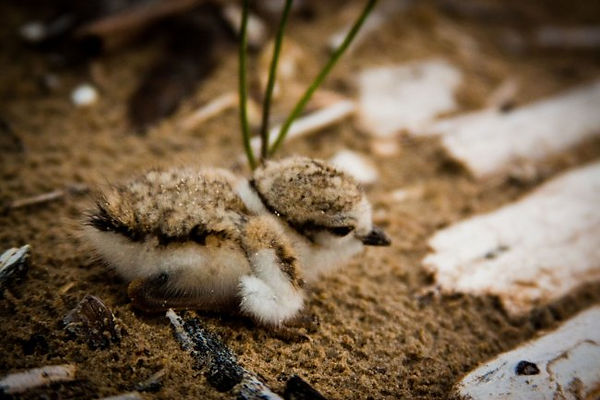
Resources | Coastal Flora and Fauna
Piping Plover
The Piping Plover (Charadrius melodus) is a small, stocky, sandy-colored bird resembling a sandpiper. The adult has yellow-orange legs, a black band across the forehead from eye to eye, and a black ring around the base of its neck.
Like other plovers, it runs in short starts and stops. When still, the piping plover blends into the pale background of open, sandy habitat on outer beaches where it feeds and nests.

Piping Plovers return to their breeding grounds in April or early May. Following establishment of nesting territories and courtship rituals, the pair forms a depression in the sand. The nest is sometimes lined with small stones or fragments of shell. The average clutch size is four eggs.
When predators or intruders come close, the young squat motionless on the sand while the parents attempt to attract the attention of the intruders to themselves, often by feigning a broken wing.
Plovers will re-nest and fledglings from these late nesting efforts may not be flying until late August.
Plovers often gather in groups on undisturbed beaches prior to their southward migration. By mid-September, both adult and young plovers will have departed from their wintering areas.


Piping plovers may live to be 8-10 years old.
Piping plovers utilize the open, sandy beaches, barrier islands, and sand spits formed along the Great Lakes' perimeters by wave action.
They do not inhabit lakeshore areas where high bluffs formed by severe erosion have replaced beach habitat. They prefer sparsely vegetation open sand, gravel, or cobble for a nest site. They forage along the strand line where invertebrates are most readily available.
In 2007, Piping Plovers nested at Sauble Beach for the first time in over 30 years. Plovers returned in 2008 to Sauble Beach and Oliphant, and at Sauble Beach in 2009. In 2009 three nests produced nine fledglings.
Threats
The main threats to Piping plover include increased development and recreational use of beaches. Piping plovers are very sensitive to the presence of humans. Too much disturbance causes the parent birds to abandon their nest. People (either on foot or in a vehicle) using the beaches where the birds nest sometimes accidentally crush eggs or young birds. Dogs and cats often harass and kill the birds. Other animals, such as fox, gulls, and crows, prey on the young plovers or eggs.
How You Can Help
-
Learn more about the piping plover and other endangered and threatened species. Understand how the destruction of habitat leads to loss of endangered and threatened species and Canada’s plant and animal diversity. Tell others about what you have learned.
-
Join a conservation group active in local shore conservation.
-
Protect natural coastal dune habitats by staying on boardwalks and existing trails. If walking your dog on a beach or in other natural areas, please keep it leashed to protect nesting birds.
-
Volunteer as a Piping Plover ‘Guardian’ if plovers have nested in your area.
Facilitator:
Karen Alexander
Outreach & Education Coordinator, Lake Huron Centre for Coastal Conservation
Presenter:
Suzanne Robinson
Management Biologist, Ontario Ministry of Natural Resources and Forestry
Overview:
This webinar will provide general information pertaining to Piping Plover, including identification and life history characteristics as well as the species population and distribution in Canada and the US, with a focus on the Great Lakes. It will also identify habitat needs and the threats to the species. Lastly, it will share the recovery goals and approaches, including suggestions as to how people can become involved and how to report observations and information.
This webinar was delivered Januaray 30, 2015
Additional Information
.png)